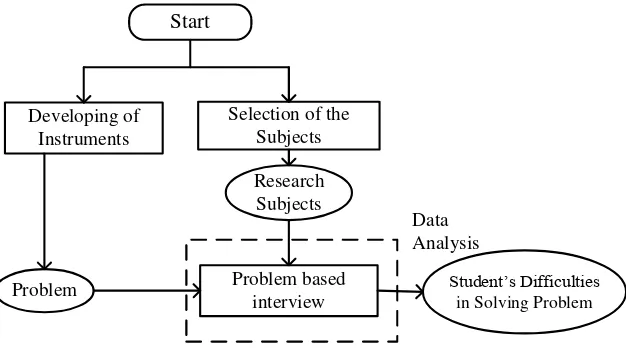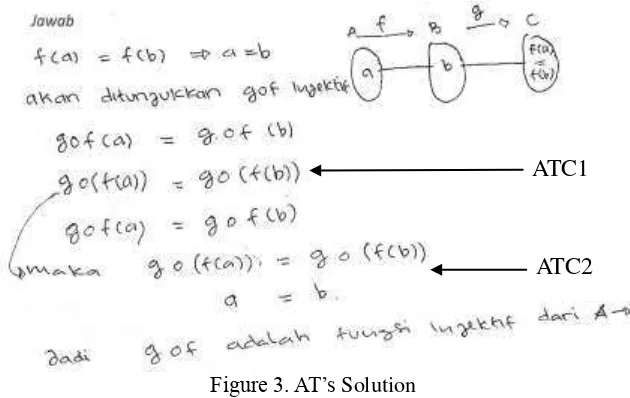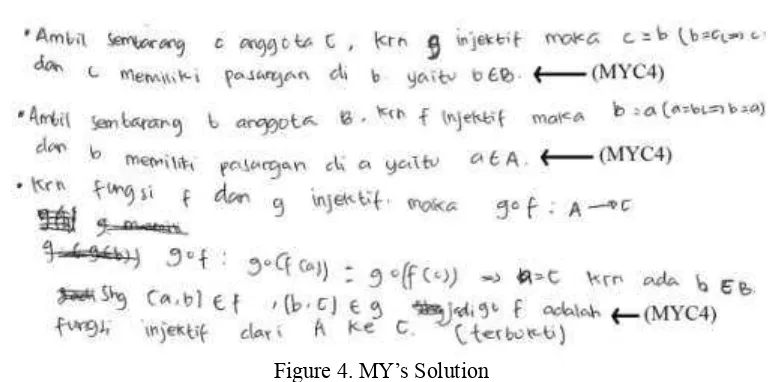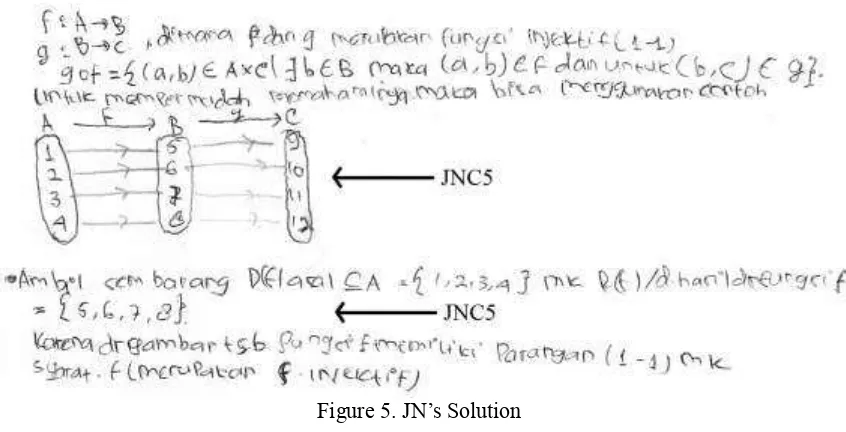ME-289
STUDENT’S DIFFICULTIES IN SOLVING PROBLEM OF REAL ANALYSIS
Dr. Jackson Pasini Mairing
Mathematics Education Deparment of University of Palangka Raya Email: [email protected]
Abstract
Main goal of learning mathematics is students able to solve mathematics problems. Students acquire high order thinking, e.g. critical and creative thinking, by solving mathematical problems. Students also acquire habits of persistent and confidence in unfamilitar conditions (NCTM, 2000). Actually, university students of mathematics education had difficulties to solve a problem to prove of Real Analysis. Subjects of the lecture can help students to have ways of mathematical thinking. The aim of this research was to describe difficulties of students to solve a Real Analysis problem. Three students had solved a problem while being interviewed by the researcher. The interview was based on Polya’s heuristic of problem solving. The activities was recorded by audiotape. The results were all students understand the problem. They could determine what is known and target/unknown of the problem. One of the students also had known concepts in the problem, but she could not synthesize the concept to make a plan. Students lack in having problem solving scheme. It is interwining between concepts in the problem and strategy of previous solved problems.
Keywords: mathematical problem, problem solving, scheme, Polya’s heuristic, Real Analysis
Problem solving is main goal of learning mathematics. In addition, students acquire ways of thinking, habits of persistent and great curiosity and confidence in unusual situations through mathematical problem solving (NCTM, 2000). Hudojo (2005) also stated that problem solving in mathematics is a "must". The goal is students are ready to face an uncertain world.
Mathematical problem itself is a situation that requires the solution and for which the solution path can not be seen directly by students (Krulik, 2003; Shumway, 1980; Sakshaug, 2002). Furthermore, Polya (1973; 1981) stated that there are two kinds of problems. They are problem to find, and problem to prove. The main objective of problem to find is to find (to form, produce, acquire, identify) a particular object that is part of the unknown of problem. In this problem, students are asked to use the rules that have been studied previously for find problem solution. The main part of the problem is (a) what to look for? (b) what data is unknown? and (c) what the condition? Whereas, the goal of problem to prove is demonstrate that a statement is true or false, but not both. The main part of this problem is hypothesis and conclusion of a theorem that must be verified.
One of the course in Mathematics Education that require students to solve mathematical problems is Real Analysis. Students need to synthesize knowledge of mathematics and logic concepts in Real Analysis to prove a statement in the course. The condition enganges students to think critically. Moreover, the problem in Real Analysis is often new for students. They need to think creatively to solve it. Therefore, students should have high order thinking to solve mathematical problems in Real Analysis.
Importance of problem solving is not followed by the students' ability to solve mathematical problems, particularly in Real Analysis course. Students had difficulties to solve some problem to prove of Real Analysis. Example of the problem is
injective.
Students have learned about the concepts in the problem at the class. However, students were still difficulties in solving it. One of the students’ solution of the problem is show in Figure 1.
Figure 1. Student’s Solution of Real Analysis Problem
Students can solve mathematical problem, if they understand the concepts related to the problem and have the appropriate problem solving scheme. Mairing (2011) stated that the National Science Olympiad medalist in mathematics junior level can have the scheme, because the medalist internalize his experience in solving problems as knowledge. Therefore, students need to practice solving problems and internalize the way of thinking in solving problems as the scheme.
Krulik (2003) stated that in problem solving, individual students use skills and understanding that are developed earlier, and applying its into an unusual situation. This process begins with the initial confrontation of the problem, and continue until a answer is obtained and the student has tested resolution process (solution). Two words that are used in this definition that should be considered, because the words have different meaning. The words are answer and solution. The solution is the whole solution process from beginning to end. Whereas, the answer is something that is “produced” at the end of the process. In the definitions, problem solving is viewed as a process.
Cognitive psychologists define problem solving as a thinking directed to solve a problem which involves both formation and selection of possible responses (Solso, 1995). Thinking itself is defined as process of generating new mental representation through transformation of information that involves a complex interaction between mental attributes such as assessment, abstraction, imagination and problem solving. Marpaung (1987) stated that thinking or cognitive process is a process that consists of receiving information (from outside or from within the students), processing, storage and retrieval of information from students’ memory.
One of heuristics of problem solving related specifically to mathematics was expressed by Polya (Polya, 1973). The heuristic is (1) understand the problem, (2) devise a plan, (3) carry out the plan, and (4) look back. At first stage, students must understand a problem. The next steps can not be done if they do not understand it. Matlin (1994) stated that there are two steps that must be done to understand a problem. First, students need to pay attention to relevant information by ignoring irrelevant information. Second, they determine how to represent a problem. If students retain a problem as an abstract object (not representing it), then they will face difficulties. Some effective methods for representing a problem are forming in (1) symbol, (2) list, (3) matrix, (4) hierarchical tree diagram, (5) graph or (6) visual image.
ME-291
students’ prior experience and knowledge. Just remembering is not enough to raise a good idea. Students can not have an idea without collecting back the related facts. The facts that be needed to solve a problem are previous mathematical knowledge. The knowledge is problems have solved or theorems have learned by students.
Devising a plan and emerging ideas to solve a problem are not easy. The activities require a prerequisite knowledge, good mental habits, and concentration/focus on the target. The carrying out the plan is easier than devising a plan, what needed is patience. A plan provide an outline way of solution. Students must convince themselves that the details of the implementation in accordance with the outline. Furthermore, they must examine the details one by one patiently until everything is clearly visible.
Now the students have implement the plan and write a solution, then they need to check the solution. This is done by students so they have reasonable justification to believe that the solution is true. Looking back can be done by check each steps of solution or the answer has satisfy the model of the problem (Mairing, 2011, 2012)
Student’s difficulties in solving problem to prove in this study are viewed in terms of
the phases of Polya. At the first phase, why a student can not understand problem to prove in Real Analysis? There are several possible causes: (a) the student does not understand the words in the problem, (b) the student does not understand concepts that exist in the problem, (c) the student can not identify important information of the problem, or (d) the student does not know the target of proof (Pepe, 2004). Polya (1973: 6) stated that students can not solve a problem if they do not understand it.
However, if the student understand the problem, why the student can not make a plan? There are several possible causes (Weber, 2001; Muir, 2008): (a) the student does not have knowledge about the strategies of prove, (b) the student does not have knowledge of the theorems which are important and when these theorems are useful, (c) the student does not have knowledge when to use the strategy of syntactic and when not to use it, (d) the student has never solve a problem that has similar structure to the problem encountered, (e) the student has solve the similar problem, but the student can not take advantage of the plan of the previous solved problem for devise a new plan, or (f) the student use the same plan for all problems encountered include the problem is being solved.
At the next phase, why student can go wrong in carrying out the plan? Possible cause is the student perform arithmetic operations without meaning (Llinares and Roig, 2008). The mistake can be avoided, if the student check the solution.
Students’ difficulties in solving problem need to be fixed particulary in Real Analysis. If lecturer knows the students common difficulties, then lecturer can anticipate better or can devise a lesson plan that can minimize the difficulites. In order to know the difficulties, lecturer should identify errors that are made by students in solving problem to prove. Furthermore, lecture need to search factors that caused the difficulites. Based on the factors, lecture can implement learnings to improve students ablity in solving problems.
Therefore, researcher conduced research which aim is describe the difficulites that are made by mathematics education students in solving problem to prove of Real Analysis course and the causative factors. The difficulites are described based on the heuristic Polya, e.g. students difficulties in understanding problem, devising a plan, carrying out the plan and looking back.
RESEARCH METHOD
sentences or student’s writing which obtained from problem based interviews. Therefore, the study is descriptive-qualitative research.
The subjects is three mathematics education students from one of the university in Palangka Raya that are learning Real Analysis course. The subjects were selected with the following criteria: (a) the three students have different abilities in Real Analysis, and (b) the students can communicate their thinking verbally. The ability is seen from the student activity in the class.
Based on the aim of the research, the researcher designed a study with a summary of the stages as follows.
1. The researcher select three subjects based on the criteria that have been determined. 2. The researcher determine a problem to prove.
The problem is
Prove that if is injective and is injective, then the composite is a injective map of onto (Bartle and Sherbert, 2011: 11).
3. The researcher develop list of questions (interview instrument) that is used to explore student’s difficulities in solving problem to prove.
4. The researcher conduct interview based on the problem to the subjects. The interview divide into four phases based on Polya’s heuristic: (a) the researcher ask to the subject to read the problem, (b) the subject explain his/her understanding of the problem, (c) the subject explain his/her plan to solve the problem, (d) the subject write the solution, (e) the researcher ask some questions based on the subject’s solution, and (f) the researcher ask some questions to explore how student check the solution. The interview is audiotaped.
5. The interview is transcribed and analyzed to obtain a description of the student’s difficulties
in solving problem to prove and the causative factors.
The stages are not linear. The summary of these stages can be seen in Figure 2.
Research
Figure 2 Summary of the Research Stages
The data analysis technique use model of flow that is proposed by Miles & Huberman (1992) that includes the following activities.
ME-293
difficulty is made by subject based on Polya’s phases (U = understand, P = plan, C = carry out the plan, and L = look back). Fourth digit is order of diffuculties in each phase of Polya. 2. Presentation of data is done by organizing the coding in a natural sequence. Natural sequence
here is based on the time sequence of each student activity in solving the problem to prove. 3. Drawing conclusions and verification. The conclusion is made by give meaning and
explanation of the results of data presentation. It is done by analyze the words/ phrases/sentences. Analyzing of words/phrases/sentences is done by: (a) read the interview transcript, (b) focus on words/phrases/sentences that significantly interesting, (c) list the possible meanings of the words/phrases/sentences that come to mind, and (d) back to the transcript of the interview to determine the appropriate meaning (Strauss & Corbin, 1998). These activitis is not hierarchical, but it is a tangle of interacting activities from before, during, and after data collection.
RESULTS OF RESEARCH AND DISCUSSION
The researcher interviewed three subjects AT, MY and JN respectively. The interviews were based on four phases of Polya.
AT’s Difficulties in Solving Real Analysis Problem
Understanding Problem Phase. AT could determine the known and the unknown/target of the problem and explain definition of injective function. However, she had dificulties to explain definition of function composition and to find where and
. AT had not meaningful understanding of composition function concept. The
researcher gave code ATU1 of the difficulties.
Devising Plan Phase. AT had difficult to devise plan. The citation of the transcript of interview as follows (where R is the researher - translated into English):
R : To show is injective, what will you do or write? AT : First, the definition of injective function.
R : Then ..
AT could not devise plan. Whereas, she had learn in the class how to solve a problem: “Let
mathematical symbols of composition function (ATC1). It was caused by AT had not meaningful understanding of the concept. Furthermore, she had not knowledge of problem solving strategies. AT used the target/unknown of the problem as the known (ATC2). These difficulities can see in Figure 3. The lack of understanding made AT cannot justify the solution (ATC3).
Figure 3. AT’s Solution
Looking Back Phase. AT had look back the solution and aware that the solution is not correct yet. Nevertheless, she did not know where the error and how to fix it (ATL1). The citation of the interview transcript as follows.
R : Did you check the solution? AT : I did, but just look it.
R : After you look it, did you think the solution is true? AT : I feel it isn’t true, Sir. I just know like this
MY’s Difficulties in Solving Real Analysis Problem
Understanding Problem Phase. MY could determine the known and the target/unknown of the problem. She had difficulty to find composition function where and
(MYU1). She said: “I never learn it”. Whereas, she had learn how to solve previous
problem in the class. MY did not relate the composition concept that was learn in the class to existing schema in her thinking.
Devising Plan Phase. MY made an inappropriate plan. She used solution path of another problem which differ in concept as the plan (MYP3). The problem is “prove that if and are surjective, then is surjective”. She was belief that the plan is appropriate, the fact, it is not. The condition is called pseudoplan.
Carrying Out the Plan Phase. Based on the pseudoplan, she made a solution (Figure 4).
ATC1
ME-295
Figure 4. MY’s Solution
MY used surjective concept into injective concept (MYC401, MYC402 and MYC403). The pseudoplan become pseudosolutioning.
Looking Back Phase. MY looked back the solution. She wrote the solution twice. The second (Figure 4) was revision from the first solution. She was belief that the solution is true, the fact, it is not (MYL2).
JN’s Difficulties in Solving Real Analysis Problem
Understanding Problem Phase. JN could answer definition of composition function and injective function. She also could determine the known and unknown/target of the problem.
P : What is the known of the problem?
JN : is function from to and from to . And, and are injective functions. P : What is the target?
JN : Prove circle injective.
Devising Plan Phase. JN had known concepts in the problem, but she could not synthesize the concept to make a plan. She used example of the concepts to prove that is injective. She said: "... make a picture, Sir. Now match to , then from function before to with function by condition injective...”. JN did not have knowledge of problem solving strategies (JNP4).
Figure 5. JN’s Solution
Looking Back Phase. JN did not look back the solution (JNL3).
The difficulties of both the students can see in Table 1.
Table 1, Students’ Difficulties in Solving Problem of Real Analysis POLYA’S PHASE THE STUDENTS
AT MY JN
Understanding Problem U1 U1 -
Devising Plan P1, P2 P3 P4
Carrying Out the Plan C1, C2, C3 C4 C5
Looking Back L1 L2 L3
where:
U1 = student had not meaningful understanding of the concept in the problem. P1 = student had not problem solving scheme.
P2 = student had doubtful to the plan.
P3 = student used solution path of another problem which differ in concept as the plan (pseudoplan).
P4 = student did not have knowledge of problem solving strategies. C1 = student made an error using mathematical symbols of some concepts. C2 = student used the target/unknown of the problem as the known.
C3 = student could not justify the solution because the lack of understanding of some concepts.
C4 = student made pseudosolutioning.
C5 = student used example of the concepts to prove the problem L1 = student did not know where the error and how to fix it.
L2 = student looked back the solution and belief that the solution is true, the fact, it is not.
L3 = student did not look back the solution.
ME-297
difference to other researchs. The dificulties U1, P1, P3, and P4 are similar to Weber (2001), Pepe (2004) and Muir (2008). Whereas, the difficulties P2, C1 – C5, and L1 – L3 differ from those researchs. Therefore, the results of this study enrich theories of student’s dificulties in solving mathematical problem especially problem to prove of Real Analysis.
BIBLIOGRAPHY
Bartle, R. G., & Sherbert, D. R. 2011. Introduction to Real Analysis, Fourth Edition. New York: John Wiley & Sons, Inc.
Hudojo, H. (2005). Kapita Selekta Pembelajaran Matematika. Malang: Universitas Negeri Malang.
Krulik, S., Rudnik, J., and Milou, E. (2003). Teaching Mathematics in Middle Schools. A Practical Guide. Boston: Pearson Education Inc.
Llinares, S., & Roig, I. (2008). Secondary School Students Construction and Use of Mathematical Models in Solving Word Problems. International Journal of Science and Mathematics Education, 6(4): 505–532.
Mairing, J. P. (2011). Profil Pemecahan Masalah Siswa Peraih Medali OSN Matematika. Jurnal Pendidikan dan Pembelajaran, 18(1): 61–71.
Mairing, J. P. (2012). Perbedaan Profil Pemecahan Masalah Peraih Medali OSN Matematika Berdasarkan Jenis Kelamin. Jurnal Ilmu Pendidikan, 18(2): 125–134.
Marpaung, Y. (1987). Struktur Kognitif dalam Pembentukan Konsep Algoritma Matematis. Sumbangan Pikiran terhadap Pendidikan Matematika Dan Fisika. Pusat Penelitian Pendidikan Matematika/Informatika se-DIY dan Jawa Tengah di FPMIPA, IKIP Sanata Dharma Yogyakarta Mrican.
Matlin, M. W. (1994). Cognition, Fourth Edition. Orlando: Harcourt Brace College Publishers.
Miles & Huberman. (1992). Analisis Data Kualitatif. Terjemahan oleh Tjetjep Rohendi Rohidi. Jakarta: UI Press.
Muir, et. al. (2008). “I’m not very good at solving problems”: An exploration of Student’s problem solving behaviours. The Journal of Mathematical Behaviour, 27(2): 228–241.
NCTM. (2000). Principles and Standards for School Mathematics. Reston, VA: NCTM, Inc. Pape, S. J. (2004). Middle School Children’s Problem Solving Behavior: A Cognitive Analysis
from a Reading Comprehension Perspective. Journal for Research in Mathematics Education, 33(3), 187-216.
Polya, G. (1973). How to Solve It, Second Edition. New Jersey: Princeton University.
Polya, G. (1981). Mathematical Discovery: on Understanding, Learning and Teaching Problem Solving, Combined Edition. New York: John Willey & Sons, Inc.
Sakshaug L., Olson, M., and Olson, J. (2002). Children are Mathematical Problem Solvers. Reston, VA: NCTM, Inc.
Strauss, A. & Corbin, J. (1998). Basics of Qualitative Research, Tehniques and Procedures for Developing Grounded Theory. Thousand Oaks: Sage Publications Inc.




